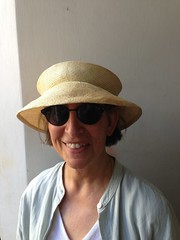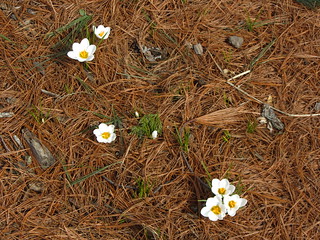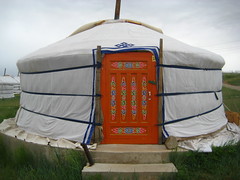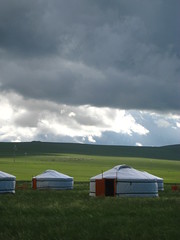
I'm a writer, publishing both as SJ Rozan and, with Carlos Dews, as Sam Cabot. (I'm Sam, he's Cabot.) Here you can find links to my almost-daily blog posts, including the Saturday haiku I've been doing for years. BUT the blog itself has moved to my website. If you go on over there you can subscribe and you'll never miss a post. (Miss a post! A scary thought!) Also, I'll be teaching a writing workshop in Italy this summer -- come join us!
Read/Post Comments (7)

The Mongolian ger
Outside UB, Mongolia has very few hotels. In some of the towns we saw a couple, but they're minimal and oriented toward business travelers: mining engineers, yak-wool traders, speculators in cashmere futures doing on-the-ground research. Those hotels assume a little Mongolian, local contacts, and a reason to be there that doesn't include comfort and relaxation. It's an industry the Mongolians are only just learning.
The ger, on the other hand, has been refined and perfected over at least a millenium. The ger in Genghis's day was the same as the ones we stayed in. Of course, after he became Great Khan, Genghis himself had one that was enormously bigger than ours, which were the size of the ones normal Mongolian families use.
A ger is a round tent.

In some parts of the world the same thing is called a yurt.
It consists of thick felt walls wrapped around a wood lattice framework; the roof is also thick felt, laid on struts that angle from the walls to the ring around the central opening, which itself is supported on two posts. The stovepipe runs through the opening. The felt's pulled back from the opening in good weather, drawn over it again in bad. The whole thing's covered in white canvas and tied around with ropes or canvas belts. It's weighted down inside with a rock hanging from the opening, and also outside with more rocks, bricks, concrete blocks, or often old machine parts. The ger has a wooden door which traditionally faces south. It has no windows.

Inside the tourist ones, there's a bed on each side, sometimes a third (or in a big ger two) opposite the door. There's a low table, where you find your thermos of hot water. There are also low stools, the stove and the wood box. Sometimes your ger might have a couple of chairs, too; some of the beds are fancier than others; occasionally a ger will have a chest of drawers. Here's the thing, though: they're basically all the same.
This may not seem like a good thing, and the no-windows part may seem claustrophobia-making. But think of it from a nomad's point of view. The scenery outside both endless -- some of the longest views you've ever seen, over those steppes -- and, every three or four months, it changes. It's a big world out there, at best neutral, at worst hostile. Lots of wind, lots of cold. You pick up the entire house and move it every now and then, plunking it down somewhere different.

So this cozy interior, completely focused in, shuts out the world, the disorienting sense a person must get the first few days in the new pasture, the weather, the intimidating distance. Everyone you love and everything you need is right here, at hand. You might even say it's womblike. You just might.
For lots more ger photos, go here and be sure to click through to "next" -- there are three pages of gers.
The ger, on the other hand, has been refined and perfected over at least a millenium. The ger in Genghis's day was the same as the ones we stayed in. Of course, after he became Great Khan, Genghis himself had one that was enormously bigger than ours, which were the size of the ones normal Mongolian families use.
A ger is a round tent.

In some parts of the world the same thing is called a yurt.
It consists of thick felt walls wrapped around a wood lattice framework; the roof is also thick felt, laid on struts that angle from the walls to the ring around the central opening, which itself is supported on two posts. The stovepipe runs through the opening. The felt's pulled back from the opening in good weather, drawn over it again in bad. The whole thing's covered in white canvas and tied around with ropes or canvas belts. It's weighted down inside with a rock hanging from the opening, and also outside with more rocks, bricks, concrete blocks, or often old machine parts. The ger has a wooden door which traditionally faces south. It has no windows.

Inside the tourist ones, there's a bed on each side, sometimes a third (or in a big ger two) opposite the door. There's a low table, where you find your thermos of hot water. There are also low stools, the stove and the wood box. Sometimes your ger might have a couple of chairs, too; some of the beds are fancier than others; occasionally a ger will have a chest of drawers. Here's the thing, though: they're basically all the same.
This may not seem like a good thing, and the no-windows part may seem claustrophobia-making. But think of it from a nomad's point of view. The scenery outside both endless -- some of the longest views you've ever seen, over those steppes -- and, every three or four months, it changes. It's a big world out there, at best neutral, at worst hostile. Lots of wind, lots of cold. You pick up the entire house and move it every now and then, plunking it down somewhere different.

So this cozy interior, completely focused in, shuts out the world, the disorienting sense a person must get the first few days in the new pasture, the weather, the intimidating distance. Everyone you love and everything you need is right here, at hand. You might even say it's womblike. You just might.
For lots more ger photos, go here and be sure to click through to "next" -- there are three pages of gers.
Read/Post Comments (7)
Previous Entry :: Next Entry
Back to Top